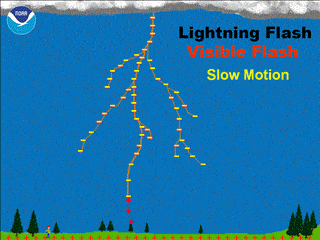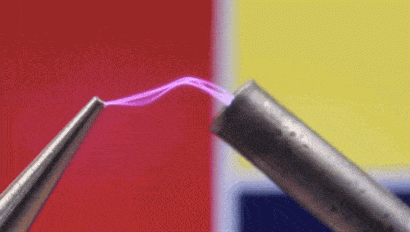During a thunderstorm, lightning often appears to flash instantaneously from cloud to ground, but there’s much more going on than meets the eye! Friction between air currents causes a buildup of negative charge in the lower parts of the clouds. Like charges repel each other, so the excess negatives begin developing an escape route. Strong, invisible electric “feelers”, called stepped leaders, branch downwards through the air.
As stepped leaders inch closer to Earth’s surface, they leave a conducting path in their wake. Their electromagnetic field also 
Given an unbroken conducting path to follow, the negative charges built up along the stepped leader flow rapidly into the ground. The lowest charges are the first to dissipate, clearing the way for charges higher up to follow downwards along the same channel. This upward propagation of charge movement emits visible light, as shown in the NOAA gif at left. Stepped leaders emit light, too, but very faintly. Since the whole process happens incredibly quickly, our view is dominated by the brighter return stroke.
What Color is Lightning?
Thunderstorms can be incredible to experience. From the bright flash of lightning that is often almost too fast to see, to the immense crack of nearby thunder that can make your heart feel like it skips a beat, they truly are a demonstration of the power of nature. Lightning usually carries between 100 million and 1 billion volts of electricity, which allows it to jump all the way from clouds to the ground. As it does so, some of that energy is transferred to the atoms in the air. This energy is released as light, which is how we see it.
This means that it is the air itself which determines what the air looks like. On Earth, our air is made up of about 78% nitrogen, 21% oxygen, and a bunch of other gases like water vapor, carbon dioxide and argon. When we put electricity through it, it gives off a characteristic glow:
The Oudin Coil generates up to 50,000 volts of electricity–much much less than a thunderstorm. This allows the electricity to jump about an inch, rather than the miles between clouds or to the ground of an actual lightning strike. However, when it arcs through the air, this still produces a similar look and identical color, which here is purple. People actually report lightning to be many different colors. In general, nearby lightning will have a purple glow due to the composition of the atmosphere, and the central part will look white simply because it is so overpoweringly bright and doesn’t give time for eyes to adjust. Most other colors that are reported are because the lightning is being viewed from a long ways off and the light has to travel through dust, rain, haze, pollution, or other things that can change its color.




